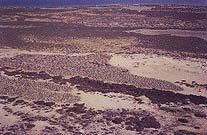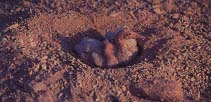SOCOTRA CORMORANTS
Simon Aspinall
Pictures by Simon Aspinall & Mike Hill
 The Socotra Cormorant (Phalacrocorax nigrogularis) is endemic to
the Arabian peninsula. There are now only thirteen or fourteen
colonies extant from a historical minimum of 28 formerly occupied
sites: just one or two of the presently known breeding colonies
lying outside the Arabian Gulf.
The Socotra Cormorant (Phalacrocorax nigrogularis) is endemic to
the Arabian peninsula. There are now only thirteen or fourteen
colonies extant from a historical minimum of 28 formerly occupied
sites: just one or two of the presently known breeding colonies
lying outside the Arabian Gulf.
In the winter breeding season of 1994/95 a coordinated international effort was made by all Gulf States to accurately census those remaining colonies and monitor breeding performance. This involved researchers in Saudi Arabia (3 colonies), Bahrain (1), Qatar (1) and the United Arab Emirates (7). The Arabian Gulf breeding population is now, for the first time, accurately known. A minimum of 220,000 pairs were found with nearly three-quarters of this total breeding on the Hawar Islands. Both Saudi Arabia and the UAE support around 32,000 pairs. To our knowledge the Gulf of Oman population was uncounted but one of the sites may possibly still hold 3000 - 6000 pairs. The Socotra Cormorant is extinct as a breeding species in Kuwait and breeding is unconfirmed in Iran since 1972.
The breeding biology, currently being investigated in Saudi Arabia, is complicated apparently by sequential breeding, with a great deal of asynchrony in any one colony, and by a large number of relays. Sequential breeding allows a greater number of pairs to occupy a single island than might otherwise be accommodated at any one time. This is likely to prove to be a useful adaptation since there are fears for the successful conservation of this species.
 In view of the small number of colonies, and despite a world population
estimated to lie between 600,000 and 1 million individuals, the
Socotra Cormorant is coming under increased threat. It continues
to be persecuted and has been evicted from several breeding sites
by development. It is not known, nor will it ever be, whether
displaced birds were able to relocate or were successfully absorbed
by other existing colonies. Squeezing into a smaller number of
sites may be one answer, if resources allow; but it would be far
more desirable to protect extant colonies. Development and birds
are not mutually exclusive but the Arabian Gulf, with over 95
per cent of the world population of Socotra Cormorants, is rapidly
running out of suitably managed and sympathetically developed,
or better still, undeveloped, islands.
In view of the small number of colonies, and despite a world population
estimated to lie between 600,000 and 1 million individuals, the
Socotra Cormorant is coming under increased threat. It continues
to be persecuted and has been evicted from several breeding sites
by development. It is not known, nor will it ever be, whether
displaced birds were able to relocate or were successfully absorbed
by other existing colonies. Squeezing into a smaller number of
sites may be one answer, if resources allow; but it would be far
more desirable to protect extant colonies. Development and birds
are not mutually exclusive but the Arabian Gulf, with over 95
per cent of the world population of Socotra Cormorants, is rapidly
running out of suitably managed and sympathetically developed,
or better still, undeveloped, islands.
Web Links | Subjects | Search
Arabian Wildlife. Volume 2, Number 3